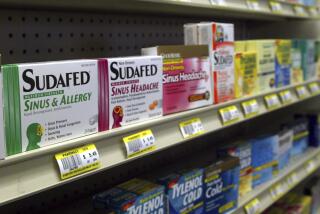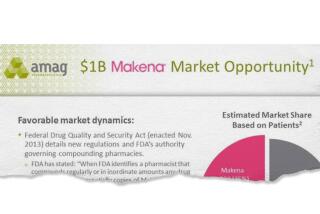FDA Says Seldane Should Be Withdrawn
- Share via
WASHINGTON — The Food and Drug Administration will take steps to remove Seldane, a prescription antihistamine popular among allergy sufferers, from the market because it has been linked to potentially fatal heart problems when taken with certain other drugs, the agency said Monday.
Seldane is not regarded as an “imminent hazard,” which is why it is not being withdrawn immediately, but its potential risks now outweigh its benefits since Allegra, a chemically similar but safer compound, recently became available, agency officials said.
But Charles Rouse, a spokesman for Kansas City-based Hoechst Marion Rousel, which makes both Seldane and Allegra, said that the company would fight the FDA attempt to remove “a safe and effective product for unnecessary reasons.”
The drug maker has 30 days to respond to the FDA’s proposed withdrawal, after which a hearing is likely. It could take months before the matter is resolved.
In situations the FDA considers extremely dangerous, it has the power to issue an immediate recall of a drug or food. Agency officials said that they do not regard Seldane as being in this category.
“The risk [of Seldane] is not very large, but Allegra gives you everything [Seldane] gives you, so now we can’t think of anyone who would be better off taking Seldane,” said Dr. Robert Temple, the associate director for medical policy for the FDA’s center for drug evaluation and research.
Seldane, one of the most widely used products in the world, was introduced in 1985 and hailed as the first treatment for allergies that did not cause drowsiness. It is now sold in 270 other countries and, in 1995, reaped $400 million in wholesale business in the United States. In the first 11 months of 1996, pharmacists filled 4.3 million prescriptions for Seldane and 2.3 million for a variation, Seldane-D.
Allegra, approved in July, is sold thus far only in the United States.
Rouse said the company would recommend that patients taking Seldane change to Allegra, but “we would like to make sure that patients are switched in an orderly and well-informed fashion--and not stop taking the product [Seldane] because they are scared,” he said.
However, Rouse added, “If you don’t fall into a category of risk, there is no reason to stop taking Seldane.”
*
The FDA began receiving reports several years ago of serious and sometimes deadly cardiac arrhythmias in patients who were using Seldane and had liver disease or who were taking other drugs, including erythromycin, an antibiotic, and ketoconazole, an antifungal.
Warnings were added to Seldane’s labeling and the company launched a massive education program, including letters to doctors, to prevent the drug interactions that might cause the cardiac reaction.
“We know that co-prescribing is way down, but it isn’t zero and it’s never going to be zero,” the FDA’s Temple said. “The risk was considerable and has been greatly reduced by responsible promotion and labeling. But now a patient can get the same thing Seldane offers in a drug that appears to be safe.”
The drug interaction apparently causes a buildup of terfenadine--the main chemical ingredient of Seldane--in the blood, resulting in the heart irregularities.
Allegra, on the other hand, contains fexofonadine, the primary active derivative of terfenadine that is produced in the body when terfenadine is taken.
However, it does not appear to cause the same cardiac problems when taken with these other commonly prescribed medications, thus it “provides nearly all of terfenadine’s potential beneficial effects,” the FDA said.
A generic version of Seldane, made by IVAX Corp. in Miami, was approved earlier this month. The FDA said that it will be subject to the same withdrawal order, if it becomes final. IVAX also plans to challenge the decision.
“We’re going to continue to sell this drug, a more affordable generic version, during this period of deliberations, for whatever time it takes,” said Joe Jones, a company spokesman. “It is definitely worth it to us. Moreover, we continue to believe it is safe and effective when used in accordance with labeled instructions.”






